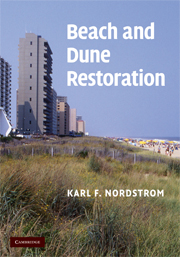Book contents
- Frontmatter
- Contents
- Preface
- Acknowledgments
- 1 The need for restoration
- 2 Beach nourishment and impacts
- 3 Dune building practices and impacts
- 4 Restoring processes, structure, and functions
- 5 Options in spatially restricted environments
- 6 A locally based program for beach and dune restoration
- 7 Stakeholder interests, conflicts, and co-operation
- 8 Research needs
- References
- Index
1 - The need for restoration
Published online by Cambridge University Press: 14 August 2009
- Frontmatter
- Contents
- Preface
- Acknowledgments
- 1 The need for restoration
- 2 Beach nourishment and impacts
- 3 Dune building practices and impacts
- 4 Restoring processes, structure, and functions
- 5 Options in spatially restricted environments
- 6 A locally based program for beach and dune restoration
- 7 Stakeholder interests, conflicts, and co-operation
- 8 Research needs
- References
- Index
Summary
The problem
The shorelines of the world are being converted to artifacts through damaging actions such as eliminating dunes to facilitate construction of buildings and support infrastructure, grading beaches and dunes flat to facilitate access and create space for recreation, and mechanically cleaning beaches to make them more attractive. Progressive beach erosion, combined with human attempts to retain shorefront buildings and infrastructure in fixed positions, can result in truncation or complete loss of beach, dune, and active bluff environments. The lost sediment may be replaced in artificial beach nourishment operations, but nourishment is usually conducted to protect shorefront buildings and provide a recreational platform rather than to restore natural values (Figure 1.1). Sometimes nourished beaches are capped by a linear dune designed to function as a dike against wave attack and flooding. Many of these dune dikes are built by earth-moving machinery rather than by aeolian processes (Figure 1.2), resulting in both an outward form and internal structure that differ from natural landforms. Dunes on private properties landward of public beaches are often graded and kept free of vegetation or graded and re-vegetated, but this vegetation cover may bear little similarity to a natural cover (Nordstrom 2003). Transformation of landscapes to tourist economies can convert distinct landscapes in different parts of the world into a single landscape of tourism, that simulates com- ponents of landscapes perceived to be effective in attracting tourists, thus dissolving geographic particularity and landscape identity (Turkenli 2005).
- Type
- Chapter
- Information
- Beach and Dune Restoration , pp. 1 - 18Publisher: Cambridge University PressPrint publication year: 2008



